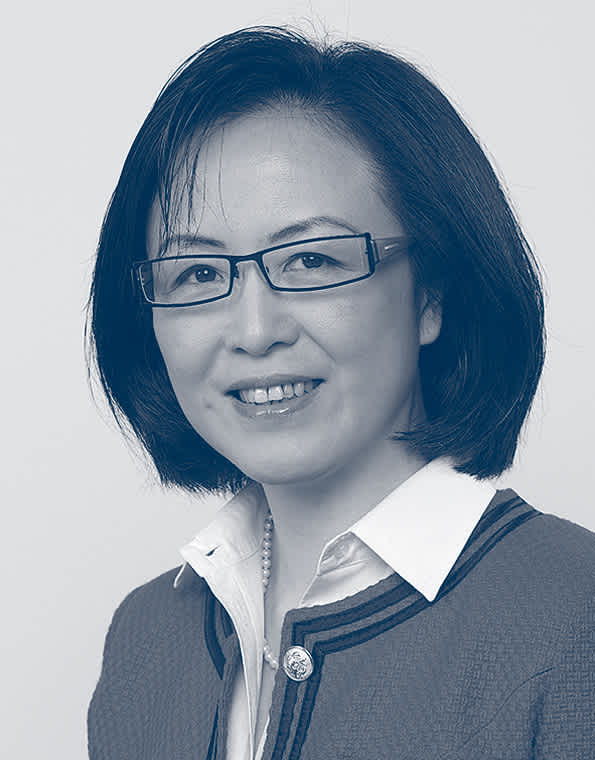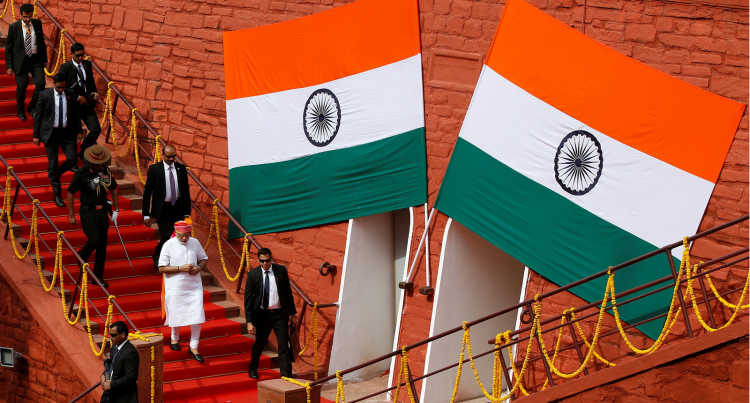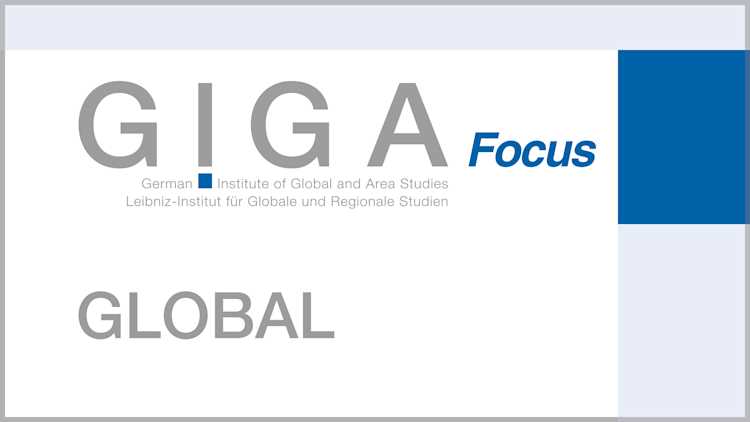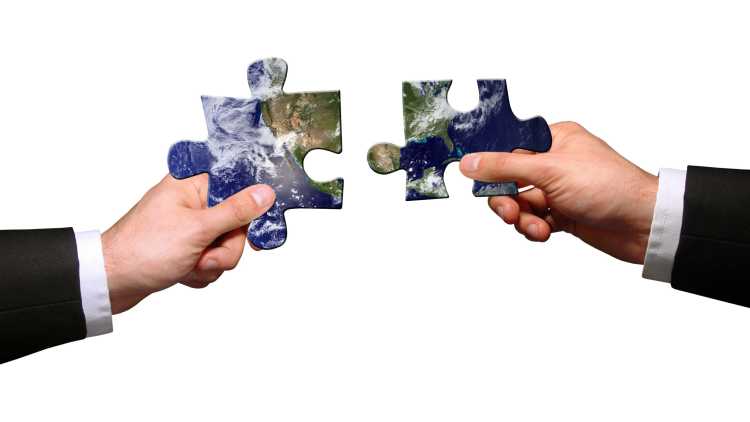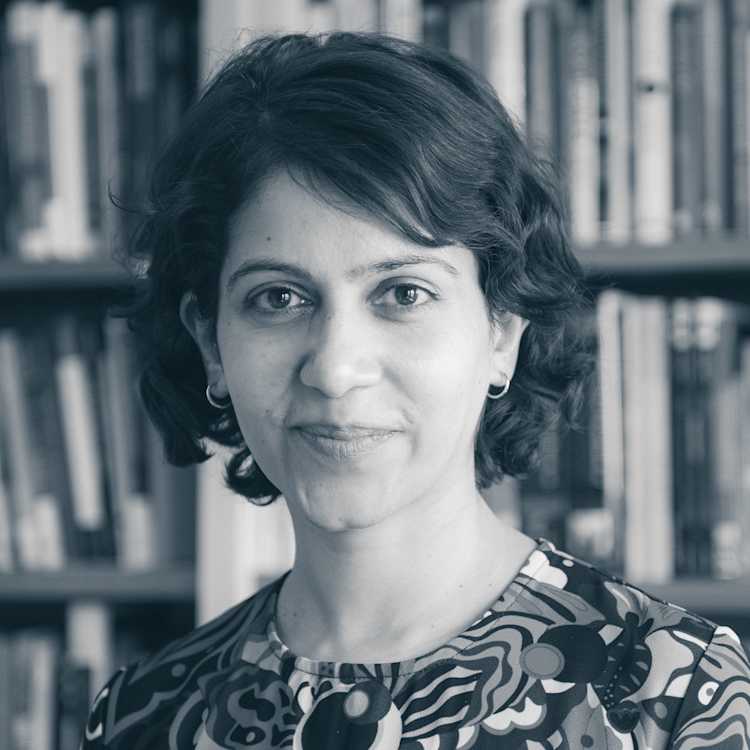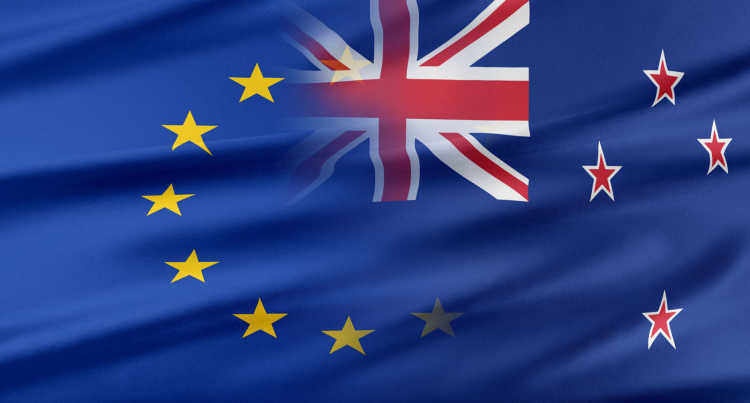- Startseite
- Publikationen
- GIGA Focus
- "It’s Asia, Stupid": Time for the EU to Deepen Relations with Asia
GIGA Focus Asien
"It’s Asia, Stupid": Zeit für ein vertieftes Engagement der EU in Asien
Nummer 6 | 2017 | ISSN: 1862-359X
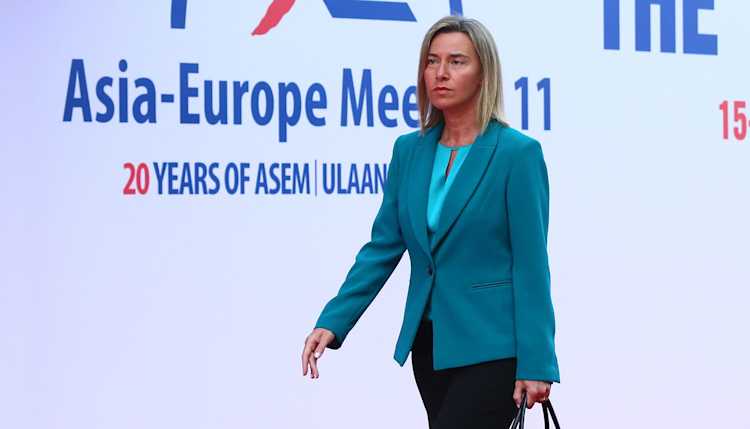
Globale Wirtschaftskräfte verschieben sich in rasanter Weise nach Asien, das inzwischen zum wichtigsten Handelspartner der EU aufgestiegen ist. Für die EU sind Frieden und Sicherheit in Asien von fundamentaler Bedeutung, zumal kaum ein Politikziel, sei es Klimapolitik oder die Wahrung multilateraler Strukturen, ohne ein konstruktives Engagement der asiatischen Länder erreichbar ist. Dies gilt umso mehr angesichts von US-Präsident Trumps Haltung gegenüber der asiatischen Region und zu globalen Fragen. Die EU muss daher Asien mehr Gewicht geben und eine kohärentere Strategie gegenüber der Region entwickeln.
Die Wachstumsraten der asiatischen Volkswirtschaften übertreffen die der EU und der USA seit vielen Jahren. Das für den asiatisch-pazifischen Raum für 2017 prognostizierte Wachstum von 5,5 Prozent liegt weit vor dem der USA (2,1%) und der EU (1,9%). Aus der Wirtschaftskraft resultiert politische Macht, und so muss die EU den asiatischen Ländern mehr Aufmerksamkeit schenken, wenn sie ihre eigenen Ziele bezüglich Handel, Klimawandel, Migration oder Terrorismus erreichen will.
Die EU muss Prioritäten setzen und sollte sich daher auf ihre strategischen Partner (China, Japan, Indien, Korea) sowie auf eine Unterstützung der ASEAN-Staaten konzentrieren. Der Rückzug der USA aus der Transpazifischen Partnerschaft (TPP) schafft neue Spielräume für die EU. Die Politik bilateraler Freihandelszonen sollte weiter verfolgt werden, da kaum Aussicht besteht, auf gesamtregionaler Ebene zu einem Freihandelsabkommen zu gelangen,
Die EU hat ein starkes Interesse an der Sicherheit der asiatischen Region schon allein deshalb, weil ein militärischer Konflikt die Lieferketten des globalen Handels unmittelbar gefährden würde. Die EU sollte deshalb Brennpunkte wie Nordkorea und Myanmar beachten und hier einen integrierten sicherheitspolitischen Ansatz, wie er bei der Operation Atalanta erfolgreich zum Einsatz gekommen ist, umsetzen.
Die EU sollte ihr Wertesystem keineswegs aufgeben, es aber mit mehr Fingerspitzengefühl und in realistischerer Weise einsetzen. Auch könnte die EU mehr für die Aufarbeitung historischer Konflikte in Asien tun, indem sie etwa ihrer eigenen historischen Rolle in der Region stärkere Aufmerksamkeit schenkt.
Fazit
Angesichts der Gefährdung des multilateralen Systems durch Trumps Präsidentschaft ist es für die EU zur Verfolgung ihrer politischen Ziele unumgänglich, stärker auf Asien zuzugehen. Als Kern einer neuen Asienstrategie der EU sollten die bestehenden strategischen Partnerschaften wiederbelebt werden. Der nächste Gipfel des Asia-Europe Meeting (ASEM) in Brüssel im Jahr 2018 sollte genutzt werden, um das Engagement für eine stärkere Partnerschaft mit Asien zu erneuern. Während Handelsfragen weiterhin im Mittelpunkt der Beziehungen zwischen der EU und Asien stehen werden, muss die Agenda um verschiedene andere globale Fragen erweitert werden.
Limited Success
The EU has been slow to recognise the importance of the rise of Asia and has struggled to make an impact as a political actor in Asia. In 2001 it agreed an ambitious goal of “strengthening the EU’s political and economic presence across the region, and raising this to a level commensurate with the growing global weight of an enlarged EU” (European Commission 2001). This was complemented by further policy papers dealing with China, India, Southeast Asia, and East Asia (Council of the European Union 2012). The European Security Strategy of December 2003, however, made scant reference to Asia but suggested that the EU should develop strategic partnerships with China, India, and Japan. More than a decade later, in 2016, the EU agreed a new global strategy which gave far more attention to Asia, stating that there was “a direct connection between European prosperity and Asian security.” It mostly focused on deepening trade and investment with China but also stated that it was ready “to make a greater practical contribution to Asian security” (European Union n.d.).
After 15 years, one can conclude that the EU has only had limited success in achieving its 2001 goal. In Asia the EU is viewed primarily as an important trading partner and supplier of development and humanitarian assistance. The EU has found it difficult to achieve a coherent and united approach to Asia, especially towards China, which is adept at playing divide and rule with the EU’s 28 member states. There are, however, signs of a change in attitude on both sides. It is increasingly clear that the EU and its member states understand the growing importance of Asia in the global system and are willing to deepen relations. The recent opening of an EU delegation in Mongolia is evidence of this trend.
For Asia, the EU is its biggest trade partner and largest provider of technical, development, and humanitarian assistance. There are large and growing research and tourism links. The new buzz word is “connectivity” – a central theme for ASEM, the Belt and Road Initiative, and EU–ASEAN relations (Schüller and Schüler-Zhou 2015). In addition, and partly in response to changes in Washington, the EU is now looking to Asia for a partner that can help to secure global security and stability, open markets, and the rule of law. It wants Asian support for a global and regional order that is based on international law, agreed rules, and strong institutions and networks rather than on “spheres of influence” or “historical rights.”
There is growing evidence that this EU approach is finding resonance. Many Asian countries joined the EU in condemning the Russian annexation of Crimea in 2014 and also welcomed the EU’s support for a peaceful resolution of disputes in the South China Sea. A number of Asian countries are participating either fully in or in parallel to the EU-led anti-piracy Operation Atalanta in the Gulf of Aden. To the surprise of many, the EU has been invited for the first time to attend the East Asia Summit, which will take place in November 2017. One of the main motives for the invitation was that the EU is now regarded as a beacon of stability and predictability compared to the instability and uncertainty brought about by President Trump’s arrival in the White House. The president has questioned US alliances in Asia, has pulled the US out of the TPP (and the Asia-supported Paris climate change agreement), and has threatened “to destroy” the Democratic People's Republic of Korea (DPRK). All these moves have given added urgency for the EU to have its own strategy towards Asia.
Why Asia Matters
Asia has recently surpassed the North American Free Trade Agreement (NAFTA) to become Europe’s main trading partner, accounting for over 40 per cent of Europe’s total trade flows. Moreover, European foreign direct investment (FDI) in Asia amounts to a third of European investment abroad and is growing. Asian investment into the EU, especially from China, is also significant and growing. Over 50 per cent of global growth in recent years has come from China, whose economy has become so big that it could well be as influential in the twenty-first century as US capitalism was in the twentieth century. Other Asian countries also continue to outperform the EU. Projected economic growth of 5.5 per cent this year in the Asia-Pacific region far outstrips the 2.1 per cent and 1.9 per cent predicted in the US and eurozone, respectively. The level of economic interdependence between the EU and Asia has reached a very high level and is critical for the future growth prospects of both sides (European Union 2016).
As the US retreats into an “America First” strategy and withdraws from the TPP, it is timely that the EU seizes the trade initiative. The EU has already concluded free trade agreements (FTAs) with South Korea, Singapore, and Vietnam, while the far-reaching FTA with Japan is almost completed. The negotiations with India, Indonesia, the Philippines, Thailand, and Malaysia are either ongoing or waiting to be resumed when political conditions change. President Juncker has called for the imminent FTA negotiations with Australia and New Zealand to be completed within a year. The ultimate goal is an EU–ASEAN FTA; however, given the large economic differences between the countries of Southeast Asia, it will be some years before serious talks start. In the meantime, negotiations are underway between the EU and ASEAN for an open skies aviation agreement.
It is important to remember that for all the excitement of “Asian miracles,” Asia still contains millions of people living in poverty. With its belief that trade can reduce poverty, the EU has granted most developing countries in Asia trade preferences under the generalised system of preferences (GSP) – providing they meet certain standards of good governance. The EU’s 2001 Everything but Arms initiative provides lesser developed countries (LDCs) with duty-free and quota-free access to the EU market. These trade concessions have seen a major increase in exports, especially textiles, to the EU market.
Although trade and development assistance has been the main EU footprint in Asia, the economic rise of Asia has brought with it political influence and responsibility. Thus, the EU has sought to engage Asia in more global issues. Perhaps the best example is climate change, where the EU is regarded as the global leader. The EU invested heavily, and successfully, in securing Asian support for the Paris climate change agreement. The EU also recognises that Asia is vital in tackling regional security issues and transnational challenges, such as terrorism and pandemics.
Trade and security are of course interlinked. Asia’s growth rests on continued regional stability. That is why the “Asian paradox” matters to non-Asians too (“Economic Asia” represents integration and optimism, while “Security Asia” represents fragmentation and pessimism). It is clear that the existing regional security architecture is not yet robust enough to manage rising tensions and geopolitical competition. All countries are hedging in the face of uncertainty about the future presence of the US in the region and the ambitions of China. ASEAN is at the heart of emerging regional cooperation frameworks and the best hope for a rules-based regional order. This is why the EU should intensify its efforts to bolster ASEAN’s capacity to deal with conflicts and crisis management.
At the same time, the EU should also urge Japan, China, and South Korea to deepen regional cooperation in North East Asia, where the political use of historical issues continues to bedevil relations between the three countries. The EU’s experience of reconciliation after 1945 is highly relevant to the region, and it could better promote this in all three countries. The Asia–Europe Foundation (ASEF) might be one organisation that could do more in this area.
How the EU Engages with Asia
The EU engages with Asia in three ways. First, on the bilateral level the EU has four strategic partners in Asia (China, Japan, India, and Korea) plus a number of other important relationships with Indonesia, Vietnam, Singapore, Australia, and New Zealand, inter alia.
The strategic partnerships have a similar structure to annual summits, ministerial meetings, and a plethora of dialogues. Most attention is focused on China, which has become increasingly active in all corners of the world, including as both an investor in Europe and a foreign policy player in regions and issues of importance to Europe. Before and after China joined the WTO in 2001, the EU saw itself as a mentor and hoped that as China moved towards a market economy the natural consequence would be greater democracy (European Commission 2006). This illusion has gone, but the EU has struggled to find a consistent and coherent approach to China, whether dealing with trade issues (e.g. solar panels, screening of investments) or political issues (e.g. human rights, the Dalai Lama). The EU maintains its arms embargo imposed after Tiananmen Square and is engaged in a dispute about market economy status for China. Despite these problems, both sides are currently negotiating a bilateral investment treaty, which could be a precursor to an eventual FTA. But much will depend on the evolution of domestic policy in China, especially economic reform. Cooperation is more positive as regards global issues, with China and the EU working closely on climate change, migration, Iran, Syria, the DPRK, Afghanistan, and African peacekeeping (European Commission 2016).
The EU is also about to finalise a strategic partnership agreement (SPA) and an economic partnership agreement (EPA) with Japan, which will be the biggest boost to global trade since China joined the WTO in 2001. It should lead to a much deeper relationship across the board as the political agreement allows for close cooperation on foreign and security policy. Prime Minister Abe views the EU as an important anchor of stability on global issues given the uncertainty and unpredictability from Washington.
South Korea is the only Asian country that has three comprehensive agreements with the EU, which cover trade, political, and security cooperation, respectively. All three are working well: bilateral trade has risen 30 per cent since the 2013 FTA was signed, there is extensive cooperation on innovation and technology, and there is growing cooperation on foreign policy, with Seoul even providing a helicopter ship to boost the EU’s Operation Atalanta. The partnership, however, is hardly visible in the eyes of the public.
India has perhaps not received the attention it deserves from the EU. At the latest summit on 6 October 2017, the two sides issued a lengthy joint statement detailing progress on many areas of cooperation. Although there has been some progress on science and education, clean energy, and maritime security, the FTA negotiations remain blocked due to lack of agreement on market access. Moreover, the two sides have generally found it difficult to cooperate on global issues such as migration and terrorism. While India shares the EU’s focus on effective multilateralism, it has been less willing to support EU action in multilateral fora including the UN and the WTO. India’s problems internally and in its neighbourhood (Afghanistan, Pakistan, Nepal, Bangladesh, and Myanmar) have also reduced its capacity to play a truly global role. India has also shown little interest in promoting democracy or human rights and has often accused the EU of hypocrisy. The EU’s efforts to address the causes of poverty in India – namely, child labour and caste and gender discrimination – have also proven to be sensitive (European Commission 2004).
Second, the EU supports regional integration, with ASEAN being the clear priority (The South Asia Association for Regional Cooperation [SAARC] has never really taken off). An ambitious new action plan for 2018–2022 was agreed in Manila in August 2017 and now needs to be implemented (European Union 2017). Apart from extensive cooperation in several areas, including customs and trade, aviation, and the environment, the EU should strengthen ASEAN’s central role in building a more robust regional architecture. The EU has relevant experience in maritime security, border management, and conflict prevention.
Third, it is a strong supporter of the Asia–Europe Meeting (ASEM) process, which brings together over 50 countries from the two continents for a biannual summit and an annual ministerial meeting. Established in 1996, ASEM has three pillars (political, economic, and sociocultural) and enables both sides to engage on a number of current issues without the presence of the US. But as with many international gatherings, lots of leaders use them for convenient bilateral meetings. Civil society is also involved through a business forum, a peoples’ forum, and the Asia-Europe Foundation (ASEF). The next summit will be held in Brussels in October 2018 and should provide an opportunity for Europe and Asia to deepen their cooperation and defend the multilateral system from attacks by Washington.
A Stronger Engagement with Asia
Given the growing importance of Asia, the EU has to deepen its engagement with Asia. First, however, the EU should put its own house in order. Asia’s view of Europe has not been improved by the EU’s poor economic record, the constant talk of secession (Brexit and Grexit), and its failure to deal with regional challenges such as migration. A strong, vibrant EU that can ensure growth, political stability, and a secure neighbourhood would do wonders for the EU’s image in Asia and elsewhere. At the same time, the EU should step up its public diplomacy efforts in Asia.
Second, the EU needs to engage in a more effective manner with Asia. Despite commitments under the Lisbon Treaty, not all member states support the EU as they should. The 16+1 arrangement, where China deals with several “new” EU member states and some Balkan countries, has brought little benefit to its members beyond an annual photo op with the Chinese prime minister. The July Foreign Affairs Council stated that any such ad hoc arrangements had to abide by EU rules and regulations. There is nothing wrong with member states promoting their bilateral relations with China, but on EU issues all member states have sufficient opportunity to influence policy through the Council working groups and the Foreign Affairs Council. The larger member states, which all have extensive bilateral relations with China, have a special duty to ensure that the views of the smaller member states are taken into account.
Apart from deepening relations with the four strategic partners, the EU should focus on a number of other priorities:
It should stay the course on Afghanistan and prevent the country slipping back into the hands of the Taliban, which would further increase the already large number of Afghan refugees coming to Europe. As noted in the EU’s strategy paper on Afghanistan in October 2017, the EU and its Asian partners have a shared interest in supporting Afghanistan’s reform and state-building processes. Billions of euros have been spent on bolstering Afghan security forces with little result to date. Working with Asian partners, including China and India, would greatly increase the chances of success in Afghanistan (European Council 2017).
The EU must help to ensure the success of democracy in Myanmar. The EU was an important partner during the transition from military rule, but Myanmar still faces huge problems, such as the need to reduce ethnic tensions (evidenced by the mass exodus of Rohingya Muslims to Bangladesh) and overhaul the education system. The success of this transition will be important not only for the people of Myanmar but also for the wider ASEAN region, where democratic norms are under pressure. The EU needs to increase its assistance for the refugees and also help oversee their return to Rakhine. If it does not, the appalling situation of the refugees in Bangladesh could become a fertile breeding ground for radical Islam forces.
The EU has to improve its cooperation in multilateral fora with Asian partners. Too often, Asian partners come after the US, Canada, and other “like-minded countries” when discussing global issues. It should become automatic to work with Asian partners in the UN, the IMF, the World Bank, ad hoc bodies, and new institutions such as the Asian Infrastructure Investment Bank (AIIB). Sometimes, it may prove most useful to cooperate with ASEM or ASEAN; however, more often it will be more fruitful to work with individual Asian countries and strategic partners, amongst others.
It should continue to promote democracy and human rights, albeit in a more sensitive and consistent manner. The EU faces major challenges in dealing with human rights abuses, inter alia, in China, Cambodia, and the Philippines. Many Asians, however, feel that the EU tends to preach rather than engage in dialogue. Double standards is a charge often levelled at the EU by some Asians, while there is still a feeling of resentment in some quarters towards the former colonial masters. The US was previously a strong partner of the EU, but as the Trump administration has shown little interest in pursuing a normative agenda, the EU finds itself more exposed. But this should not hinder it from seeking to promote universal standards of human rights. This again requires a united EU voice. Regrettably, at the UN Human Rights Council in 2017 and in other fora, not all EU member states were prepared to support statements criticising China’s human rights record.
The EU ought to promote its integrated approach towards security as it supports Asian understandings of dialogue and tolerance as well as Asian long-term orientation culture. Traditionally, the US has been the main guarantor of security in the region, which remains true in terms of hard security. Although China spends billions on its military, the US remains far ahead in terms of military capability. But as Afghanistan and Iraq have shown, military power alone does not ensure security. There is also uncertainty about the durability of US alliances, not least because of President Trump’s remarks. As Federica Mogherini said, the EU may not be an Asian power, but it is an Asian partner. The EU should thus use its invitation to the East Asian Summit to discuss a possible regional security model based on the Organization for Security and Co-operation in Europe. Although this will not be achieved overnight, a neutral outside partner like the EU could help to break the deep-rooted, historical mistrust in the region. In the absence of agreements on several sovereignty claims, notably in the South China Sea, the EU’s experience of legal frameworks and a bottom-up approach to confidence-building measures could be most valuable.
The EU must maintain its “critical engagement” policy towards the DPRK, arguably the most acute security problem in the region. Tensions are extremely high due to the increasing pace of DPRK missile testing and the resulting war of words between Donald Trump and Kim Jong-un. There are no official relations between the US and the DPRK and only very occasional unofficial contacts. The EU could thus play a greater role as it is clearly not regarded as a security threat by the DPRK. In recent years, however, EU policy has focused more on being critical than on engaging. Given the importance of maintaining channels to Pyongyang, the EU should increase its political contacts with the DPRK without deviating from its support for UN sanctions. As there is no military solution for the DPRK situation, all diplomatic, economic, and political channels should be kept open.
It should use the 2018 ASEM summit in Brussels to strengthen support for the multilateral system, which is now under sustained attack from the White House. This need not be portrayed as “ganging up on the US” but rather as demonstrating that the multilateral approach (which has served the US well since 1945) brings more peace, stability, and prosperity to the world. Connectivity should be a main theme with both sides promoting initiatives (Belt and Road and the new Arctic Route) that bring the two continents closer.
The EU ought to seek greater involvement of the Asian diaspora in Europe. There are large Asian communities in many EU member states, and some have assumed leadership positions in Portugal, Ireland, and the UK. But EU leaders rarely reach out to them or seek their support to develop closer ties with Asia. The Chinese in Italy, the Vietnamese in France, the Indonesians in the Netherlands, and the Indians and Pakistanis in the UK should be more involved in EU–Asia relations.
The EU must adopt a more modest and self-critical approach. Some Asians find the EU’s desire to help resolve disputes in their region as patronising and even hypocritical. As one former Indian foreign minister said, “when you have solved the Cyprus issue, the Catalan question, and agreed a name for Macedonia, then maybe we will listen to you on Kashmir.” Many EU leaders also show little understanding of the continued ill feeling caused by Europe’s colonial past despite the fact that the massacre of Amritsar and the Opium Wars are known to every schoolchild in India and China, respectively.
It has to present a united front in Asia. There is limited, albeit slowly growing, media coverage of the EU in Asia. The EU is primarily reported as an economic actor and the euro is the strongest symbol of European identity. The EU as a political actor rarely gets a mention even when playing a key role in important negotiations, as was the case in the Iran nuclear negotiations. Member states should display more solidarity with EU policies and allow the EU ambassador to articulate EU positions to third-country hosts. This is already provided for under the Lisbon Treaty but is not always observed.
Conclusion
Although the EU has deepened its relations with Asia in the past 15 years, it has tended to do so in response to events and in an ad hoc manner. The sheer economic weight of Asia means that the EU should now be developing a new Asia strategy that takes into account the new geopolitical and geoeconomic environments. There are two important policy papers dealing with India and Europe-Asia connectivity planned for 2018. However, the different strands of EU policy – trade, development, technical assistance, the environment, energy, security, human rights – should be integrated into a comprehensive approach that allows for greater use of linkages in order to maximise the EU’s influence. A new overarching EU strategy towards Asia could be an indispensable instrument to enhance policy coherence, promote the image of the EU as a strategic player in the entire region, and ensure the EU’s own interests and expectations are clearly defined.
Fußnoten
Literatur
Council of the European Union (2012), Guidelines on the EU’s Foreign and Security Policy in East Asia, 15 June, http://eeas.europa.eu/archives/docs/asia/docs/guidelines_eu_foreign_sec_pol_east_asia_en.pdf (24 October 2017).
European Commission (2016), Elements for a New EU Strategy on China, JOIN 30, 22 June, http://eeas.europa.eu/archives/docs/china/docs/joint_communication_to_the_european_parliament_and_the_council_-_elements_for_a_new_eu_strategy_on_china.pdf (24 October 2017).
European Commission (2006), Closer Partners, Growing Responsibilities A Policy Paper on EU-China Trade and Investment: Competition and Partnership, COM 632, 24 October, http://eur-lex.europa.eu/legal-content/en/TXT/?uri=CELEX:52006DC0632 (24 October 2017).
European Commission (2004), An EU–India Strategic Partnership, COM 430, 16 June, http://eur-lex.europa.eu/legal-content/EN/TXT/?uri=celex:52004DC0430 (24 October 2017).
European Commission (2001), Communication on Europe and Asia: A Strategic Framework for Enhanced Partnerships, COM 469, 4 September, https:// ec.europa.eu/europeaid/sites/devco/files/communication-europe-asia-strategic-framework-com2001469-20010904_en.pdf (24 October 2017).
European Council (2017), Afghanistan: Council Adopts EU Strategy, 16 October, www.consilium.europa.eu/en/press/press-releases/2017/10/16/eu-strategy-afghanistan/ (24 October 2017).
European Union (2017), ASEAN–EU Plan of Action (2018–2022), https://eeas.europa.eu/sites/eeas/files/asean-eu_plan_of_action.pdf (24 October 2017).
European Union (2016), Workshop: Trade and Economic Relations with Asia, www.europarl.europa.eu/RegData/etudes/STUD/2016/535024/EXPO_STU(2016)535024_EN.pdf (24 October 2017).
European Union (n.d.), EU Global Strategy, https://europa.eu/globalstrategy/en/global-strategy-foreign-and-security-policy-european-union (24 October 2017).
Schüller, Margot, and Yun Schüler-Zhou (2015), Chinas Seidenstraßen-Initiative trifft auf transeuropäische Infrastrukturpolitik, GIGA Focus Asien, 8, GIGA: Hamburg, www.giga-hamburg.de/en/publication/chinas-seidenstrassen-initiative-trifft-auf-transeuropaeische-infrastrukturpolitik (24 October 2017).
Gesamtredaktion GIGA Focus
Redaktion GIGA Focus Asien
Lektorat GIGA Focus Asien
Regionalinstitute
Wie man diesen Artikel zitiert
Cameron, Fraser (2017), "It’s Asia, Stupid": Zeit für ein vertieftes Engagement der EU in Asien, GIGA Focus Asien, 6, Hamburg: German Institute for Global and Area Studies (GIGA), http://nbn-resolving.de/urn:nbn:de:0168-ssoar-54741-7
Impressum
Der GIGA Focus ist eine Open-Access-Publikation. Sie kann kostenfrei im Internet gelesen und heruntergeladen werden unter www.giga-hamburg.de/de/publikationen/giga-focus und darf gemäß den Bedingungen der Creative-Commons-Lizenz Attribution-No Derivative Works 3.0 frei vervielfältigt, verbreitet und öffentlich zugänglich gemacht werden. Dies umfasst insbesondere: korrekte Angabe der Erstveröffentlichung als GIGA Focus, keine Bearbeitung oder Kürzung.
Das German Institute for Global and Area Studies (GIGA) – Leibniz-Institut für Globale und Regionale Studien in Hamburg gibt Focus-Reihen zu Afrika, Asien, Lateinamerika, Nahost und zu globalen Fragen heraus. Der GIGA Focus wird vom GIGA redaktionell gestaltet. Die vertretenen Auffassungen stellen die der Autorinnen und Autoren und nicht unbedingt die des Instituts dar. Die Verfassenden sind für den Inhalt ihrer Beiträge verantwortlich. Irrtümer und Auslassungen bleiben vorbehalten. Das GIGA und die Autorinnen und Autoren haften nicht für Richtigkeit und Vollständigkeit oder für Konsequenzen, die sich aus der Nutzung der bereitgestellten Informationen ergeben.







